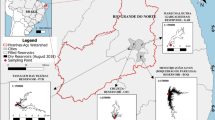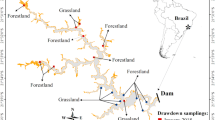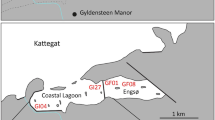Abstract
In response to climate change, prolonged droughts in semiarid regions have increased; consequently, reservoir sediments have been more frequently exposed to the atmosphere. Because of the large proportion of drawdown areas, reservoir sediments are used for agricultural activity. Agricultural intensification creates new biochemically active spots that may enhance the fluxes of carbon dioxide (CO2) and methane (CH4) after reservoir refilling. Here, we experimentally evaluated the influence of rewetting on CO2 and CH4 fluxes from the drawdown area of a Brazilian semiarid reservoir with and without agricultural activity. The observed CO2 and CH4 emissions were two and three times higher, respectively, in the sediment with agricultural activity. Higher values of organic carbon, organic matter, and nutrients in the crop-related sediment were the best predictors for the highest CO2 and CH4 emission rates. It is essential to better understand regional scenarios, such as emissions from semiarid regions, to refine the role of human-made reservoirs in the global C balance. Agricultural practices are becoming increasingly common because of extended droughts that keep reservoir sediment exposed to the atmosphere for longer periods. The response of sediments to crops suggests that land-use changes can promote positive and powerful climate feedback.







Similar content being viewed by others
Data availability
The datasets generated during and/or analyzed during the current study are available from the corresponding author on request.
Code availability
Not applicable.
References
Abril, G., F. Guérin, S. Richard, R. Delmas, C. Galy-Lacaux, P. Gosse, A. Tremblay, L. Varfalvy, M. A. dos Santos & B. Matvienko, 2005. Carbon dioxide and methane emissions and the carbon budget of a 10-year old tropical reservoir (Petit Saut, French Guiana). Global Biogeochemical Cycles 19: 1–16.
Abril, G., M. Parize, M. A. P. Pérez & N. Filizola, 2013. Wood decomposition in Amazonian hydropower reservoirs: An additional source of greenhouse gases. Journal of South American Earth Sciences 44: 104–107.
Almeida, R. M., J. R. Paranaíba, Í. Barbosa, S. Sobek, S. Kosten, A. Linkhorst, R. Mendonça, G. Quadra, F. Roland & N. Barros, 2019. Carbon dioxide emission from drawdown areas of a Brazilian reservoir is linked to surrounding land cover. Aquatic Sciences Springer International Publishing 81: 1–9.
Alvares, C. A., J. L. Stape, P. C. Sentelhas, J. L. de Moraes Gonçalves & G. Sparovek, 2013. Köppen’s climate classification map for Brazil. Meteorologische Zeitschrift 22: 711–728.
Amalfitano, S., S. Fazi, A. Zoppini, A. Barra Caracciolo, P. Grenni & A. Puddu, 2008. Responses of benthic bacteria to experimental drying in sediments from Mediterranean temporary rivers. Microbial Ecology 55: 270–279.
Amorim, M., M. A. dos Santos & J. M. R. de Camargo, 2019. Methane diffusive fluxes from sediment exposed in a Brazilian tropical reservoir drawdown zone. Journal of South American Earth Sciences Elsevier Ltd 90: 463–470.
Barbosa, J. E. L., E. S. F. Medeiros, J. Brasil, R. S. Cordeiro, M. C. B. Crispi, & G. H. G. da Silva, 2012. Aquatic systems in semi-arid Brazil: limnology and management. Acta Limnologica Brasiliensia 24: 103–118.
Barros, N., J. J. Cole, L. J. Tranvik, Y. T. Prairie, D. Bastviken, V. L. M. Huszar, P. Del Giorgio & F. Roland, 2011. Carbon emission from hydroelectric reservoirs linked to reservoir age and latitude. Nature Geoscience 4: 593–596.
Birch, H. F., 1958. The effect of soil drying on humus decomposition and nitrogen availability. Plant and Soil 10: 9–31.
Borken, W. & E. Matzner, 2009. Reappraisal of drying and wetting effects on C and N mineralization and fluxes in soils. Global Change Biology 15: 808–824.
Braga, G. G. & V. Becker, 2020. Influence of water volume reduction on the phytoplankton dynamics in a semiarid m an-made lake: A comparison of two morphofunctional approaches. Anais da Academia Brasileira de Ciencias 92: 1–17.
Braga, G. G., V. Becker, J. N.P. Oliveira, J. R. Mendonça Junior, A. F. M. Bezerra, L. M. Torres, A. M. F. Galvão & A. Mattos, 2015. Influence of extended drought on water quality in tropical reservoirs in a semiarid region. Acta Limnologica Brasiliensia 27: 15–23.
Bridgham, S. D., H. Cadillo-Quiroz, J. K. Keller & Q. Zhuang, 2013. Methane emissions from wetlands: biogeochemical, microbial, and modeling perspectives from local to global scales. Global Change Biology 19: 1325–1346.
Chapin III, F. S., P. A. Matson & H. A. Mooney, 2002. Principles of Terrestrial Ecosystem Ecology. Springer US.
Christel, W., K. Zhu, C. Hoefer, A. Kreuzeder, J. Santner, S. Bruun, J. Magid & L. S. Jensen, 2016. Spatiotemporal dynamics of phosphorus release, oxygen consumption and greenhouse gas emissions after localised soil amendment with organic fertilisers. Science of the Total Environment The Authors 554–555: 119–129.
Cole, J. J. & N. F. Caraco, 1998. Atmospheric exchange of carbon dioxide in a low-wind oligotrophic lake measured by the addition of SF6. Limnology and Oceanography 43: 647–656.
Cole, J. J., Y. T. Prairie, N. F. Caraco, W. H. McDowell, L. J. Tranvik, R. G. Striegl, C. M. Duarte, P. Kortelainen, J. A. Downing, J. J. Middelburg & J. Melack, 2007. Plumbing the global carbon cycle: Integrating inland waters into the terrestrial carbon budget. Ecosystems 10: 171–184.
Cory, R. M. & G. W. Kling, 2018. Interactions between sunlight and microorganisms influence dissolved organic matter degradation along the aquatic continuum. Limnology and Oceanography Letters 3: 102–116.
De Nobili, M., M. Contin, C. Mondini & P. C. Brookes, 2001. Soil microbial biomass is triggered into activity by trace amounts of substrate. Soil Biology and Biochemistry 33: 1163–1170.
Di Baldassarre, G., N. Wanders, A. AghaKouchak, L. Kuil, S. Rangecroft, T. I. E. Veldkamp, M. Garcia, P. R. van Oel, K. Breinl & A. F. Van Loon, 2018. Water shortages worsened by reservoir effects. Nature Sustainability 1: 617–622.
Drusch, M., U. Del Bello, S. Carlier, O. Colin, V. Fernandez, F. Gascon, B. Hoersch, C. Isola, P. Laberinti, P. Martimort, A. Meygret, F. Spoto, O. Sy, F. Marchese & P. Bargellini, 2012. Sentinel-2: ESA’s Optical High-Resolution Mission for GMES Operational Services. Remote Sensing of Environment 120: 25–36.
Evans, S. E. & M. D. Wallenstein, 2012. Soil microbial community response to drying and rewetting stress: Does historical precipitation regime matter?. Biogeochemistry 109: 101–116.
FAO, 2016. Climate change, agriculture and food security. Food and Agriculture Organization of the United Nations, Roman.
Figueiredo, A. V. & V. Becker, 2018. Influence of extreme hydrological events in the quality of water reservoirs in the semi-arid tropical region. Revista Brasileira de Recursos Hídricos 23: 1–8.
Fließbach, A., H. R. Oberholzer, L. Gunst & P. Mäder, 2007. Soil organic matter and biological soil quality indicators after 21 years of organic and conventional farming. Agriculture, Ecosystems and Environment 118: 273–284.
Fromin, N., G. Pinay, B. Montuelle, D. Landais, J. . Ourcival, R. Joffre & R. Lensi, 2010. Impact of seasonal sediment desiccation and rewetting on microbial processes involved in greenhouse gas emissions. Ecohydrology 3: 238–245.
Furlanetto, L. M., C. Palma-Silva, M. B. Perera & E. F. Albertoni, 2018. Potential Carbon Gas Production in Southern Brazil Wetland Sediments: Possible Implications of Agricultural Land Use and Warming. Wetlands Wetlands 38: 485–495.
Gallo, E. L., K. A. Lohse, C. M. Ferlin, T. Meixner & P. D. Brooks, 2014. Physical and biological controls on trace gas fluxes in semi-arid urban ephemeral waterways. Biogeochemistry 121: 189–207.
Gómez-Gener, L., B. Obrador, R. Marcé, V. Acuña, N. Catalãn, J. P. Casas-Ruiz, S. Sabater, I. Muñoz & D. von Schiller, 2016. When Water Vanishes: Magnitude and Regulation of Carbon Dioxide Emissions from Dry Temporary Streams. Ecosystems 19: 710–723.
Guérin, F., G. Abril, A. de Junet & M. P. Bonnet, 2008. Anaerobic decomposition of tropical soils and plant material: Implication for the CO2 and CH4 budget of the Petit Saut Reservoir. Applied Geochemistry 23: 2272–2283.
Huang, G., Y. Li & Y. G. Su, 2015. Effects of increasing precipitation on soil microbial community composition and soil respiration in a temperate desert, Northwestern China. Soil Biology and Biochemistry 83: 52–56.
Huxman, T. E., A. J. Leffler, K. A. Snyder, K. Ogle, S. Schwinning, D. Tissue, W. T. Pockman, D. R. Sandquist & D. L. Potts, 2004. Precipitation pulses and carbon fluxes in semiarid and arid ecosystems. Oecologia 141: 254–268.
INMET – Instituto Nacional de Meteorologia, 2021. Available in. http://portal.inmet.gov.br// (Accessed July 2021).
IPCC, 2014. Climate Change 2014: mitigation of Climate Change. Summary for Policymakers and Technical Summary. Climate Change 2014: mitigation of Climate Change. Part of the Working Group III Contribution to the Fifth Assessment Report of the Intergovernmental Panel on Climate Change. http://ebooks.cambridge.org/ref/id/CBO9781107415416A011.
Jin, H., T. K. Yoon, S. H. Lee, H. Kang, J. Im & J. H. Park, 2016. Enhanced greenhouse gas emission from exposed sediments along a hydroelectric reservoir during an extreme drought event. Environmental Research Letters 11: 124003.
Jørgensen, B. B. & N. P. Revsbech, 1985. Diffusive boundary layers and the oxygen uptake of sediments and detrit. Limnology and Oceanography 30: 111–122.
Keller, P. S., N. Catalán, D. von Schiller, H. P. Grossart, M. Koschorreck, B. Obrador, M. A. Frassl, N. Karakaya, N. Barros, J. A. Howitt, C. Mendoza-Lera, A. Pastor, G. Flaim, R. Aben, T. Riis, M. I. Arce, G. Onandia, J. R. Paranaíba, A. Linkhorst, R. del Campo, A. M. Amado, S. Cauvy-Fraunié, S. Brothers, J. Condon, R. F. Mendonça, F. Reverey, E. I. Rõõm, T. Datry, F. Roland, A. Laas, U. Obertegger, J. H. Park, H. Wang, S. Kosten, R. Gómez, C. Feijoó, A. Elosegi, M. M. Sánchez-Montoya, C. M. Finlayson, M. Melita, E. S. Oliveira Junior, C. C. Muniz, L. Gómez-Gener, C. Leigh, Q. Zhang, & R. Marcé 2020. Global CO2 emissions from dry inland waters share common drivers across ecosystems. Nature Communications 11: 1–8.
Keller, P. S., R. Marcé, B. Obrador & M. Koschorreck, 2021. Global carbon budget of reservoirs is overturned by the quantification of drawdown areas. Nature Geoscience 14: 402–408.
Koschorreck, M., 2000. Methane turnover in exposed sediments of an Amazon floodplain lake. Biogeochemistry 50: 195–206.
Kosten, S., S. van den Berg, R. Mendonça, J. R. Paranaíba, F. Roland, S. Sobek, J. Van Den Hoek & N. Barros, 2018. Extreme drought boosts CO2 and CH4 emissions from reservoir drawdown areas. Inland Waters 8: 329-340.
Leite, J. N. C. & V. Becker, 2019. Impacts of drying and reflooding on water quality of a tropical semi-arid reservoir during an extended drought event. Acta Limnologica Brasiliensia 31: e15.
Lloyd, C. R., L. M. Rebelo, & C. Max Finlayson, 2013. Providing low-budget estimations of carbon sequestration and greenhouse gas emissions in agricultural wetlands. Environmental Research Letters 8: 015010.
Lugato, E., P. Panagos, F. Bampa, A. Jones & L. Montanarella, 2014. A new baseline of organic carbon stock in European agricultural soils using a modelling approach. Global Change Biology 20: 313–326.
Marengo, J. A., A. P. M. A. Cunha, C. A. Nobre, G. G. Ribeiro Neto, A. R. Magalhaes, R. R. Torres, G. Sampaio, F. Alexandre, L. M. Alves, L. A. Cuartas, K. R. L. Deusdará & R. C. S. Álvala, 2020. Assessing drought in the drylands of northeast Brazil under regional warming exceeding 4 °C. Natural Hazards 103: 2589–2611.
Medeiros, L. C., A. Mattos, M. Lürling & V. Becker, 2015. Is the future blue-green or brown? The effects of extreme events on phytoplankton dynamics in a semi-arid man-made lake. Aquatic Ecology 49: 293–307.
Mendonça, R., R. A. Müller, D. Clow, C. Verpoorter, P. Raymond, L. J. Tranvik & S. Sobek, 2017. Organic carbon burial in global lakes and reservoirs. Nature Communications 8: 1–6.
Murphy, J. & Riley, J. P., 1962. A modified single solution method for the determination of phosphate in natural waters.
Paranaíba, J. R., G. Quadra, I. I. P. Josué, R. M. Almeida, R. Mendonça, S. J. Cardoso, J. Silva, S. Kosten, J. M. Campos, J. Almeida, R. L. Araújo, F. Roland & N. Barros, 2020. Sediment drying-rewetting cycles enhance greenhouse gas emissions , nutrient and trace element release , and promote water cytogenotoxicity. Plos One 1–21.
Petruzzella, A., C. C. Marinho, L. F. Sanches, M. Minello & F. de A. Esteves, 2013. Magnitude and variability of methane production and concentration in tropical coastal lagoons sediments. Acta Limnologica Brasiliensia 25: 341–351.
Ramirez, K. S., J. M. Craine & N. Fierer, 2010. Nitrogen fertilization inhibits soil microbial respiration regardless of the form of nitrogen applied. Soil Biology and Biochemistry Elsevier Ltd 42: 2336–2338.
Roland, F., L. O. Vidal, F. S. Pacheco, N. O. Barros, A. Assireu, J. P. H. B. Ometto, A. C. P. Cimbleris & J. J. Cole, 2010. Variability of carbon dioxide flux from tropical (Cerrado) hydroelectric reservoirs. Aquatic Sciences 72: 283–293.
Sanz-Cobena, A., J. L. Gabriel, M. Quemada, A. Vallejo, S. García-Marco & P. Almendros, 2013. Do cover crops enhance N2O, CO2 or CH4 emissions from soil in Mediterranean arable systems?. Science of The Total Environment 466–467: 164–174.
Schulz, S. & R. Conrad, 1996. Influence of temperature on pathways to methane production in the permanently cold profundal sediment of Lake Constance. FEMS Microbiology Ecology 20: 1–14.
SEMARH – Secretaria de Meio Ambiente e Recursos Hídricos do Rio Grande do Norte, 2018. Available in http://www.semarh.rn.gov.br// (Accessed December 2018).
Sponseller, R. A., 2007. Precipitation pulses and soil CO2 flux in a Sonoran Desert ecosystem. Global Change Biology 13: 426–436.
Tang, K. W., D. F. McGinnis, D. Ionescu & H. P. Grossart, 2016. Methane production in oxic lake waters potentially increases aquatic methane flux to air. Environmental Science and Technology Letters 3: 227–233.
Teodoru, C. R., Y. T. Prairie, P. A. Giorgio, C. R. Teodoru, Y. T. Prairie & P. A. Giorgio, 2011. Fluxes in a Newly Eastmain-1 Reservoir in Northern Quebec , Canada. Ecosystems 14: 28–46.
Tranvik, L. J., J. A. Downing, J. B. Cotner, S. A. Loiselle, R. G. Striegl, T. J. Ballatore, P. Dillon, K. Finlay, K. Fortino, L. B. Knoll, P. L. Kortelainen, T. Kutser, S. Larsen, I. Laurion, D. M. Leech, S. Leigh McCallister, D. M. McKnight, J. M. Melack, E. Overholt, J. A. Porter, Y. Prairie, W. H. Renwick, F. Roland, B. S. Sherman, D. W. Schindler, S. Sobek, A. Tremblay, M. J. Vanni, A. M. Verschoor, E. Von Wachenfeldt & G. A. Weyhenmeyer, 2009. Lakes and reservoirs as regulators of carbon cycling and climate. Limnology and Oceanography 54: 2298–2314.
Valderrama, J. C., 1981. The simultaneous analysis of total nitrogen and total phosphorus in natural waters. Marine Chemistry 10: 109–122.
Verpoorter, C., T. Kutser, D. A. Seekell & L. J. Tranvik, 2014. A global inventory of lakes based on high-resolution satellite imagery. Geophysical Research Letters 41: 6396–6402.
Vitousek, P. M., R. Naylor, T. Crews, M. B. David, L. E. Drinkwater, E. Holland, P. J. Johnes, J. Katzenberger, L. A. Martinelli, P. A. Matson, G. Nziguheba, D. Ojima, C. A. Palm, G. P. Robertson, P. A. Sanchez, A. R. Townsend & F. S. Zhang, 2009. Nutrient imbalances in agricultural development. Science 324: 1519–1520.
WCD, 2001. Dams and development: a new framework for decision-making: overview of the report by the World Commission on Dams. 108, 17 p.
Acknowledgements
We are grateful to André Luiz da Silva and Fabiana Araújo for assistance with sediments sampling; Gladson Rezende Marques, Suênia Campos, and Anelise Varela for assistance with laboratory analyses; Daniel Lima and Hérika Cavalcante for assistance with map; Ronaldo Angelini for assistance with statistical analyses; Laboratory of Aquatic Ecology at the Federal University of Juiz de Fora for having provided all the necessary structures and materials for this research. We thank CNPq (Brazilian National Research Council) for the financial support of the Universal Project “Quality of water availability and proposition of mitigation techniques in the face of climate change in the Brazilian semiarid region” (Process Number 407783/2016-4). AMA and VB gratefully acknowledge continuous funding through Research Productivity Grant provided by CNPq (Processes 310033/2017-9 and 308652/2019-3). This research was financed in part by CAPES (Coordenação de Aperfeiçoamento de Pessoal de Nível Superior)—Finance Code 001.
Author information
Authors and Affiliations
Contributions
Conceptualization: André M. Amado; Vanessa Becker. Data analysis: Thaís L. Pinheiro; André M. Amado; Vanessa Becker. Data curation: Thaís L. Pinheiro; André M. Amado; José R. Paranaíba, Vanessa Becker. Experimental steps: Thaís L. Pinheiro; José R. Paranaíba; Gabrielle R. Quadra. Investigation: Thaís L. Pinheiro; André M. Amado; José R. Paranaíba; Gabrielle R. Quadra, Vanessa Becker. Methodology: Thaís L. Pinheiro; André M. Amado; José R. Paranaíba; Vanessa Becker. Resources: André M. Amado; Vanessa Becker. Supervision: André M. Amado; Vanessa Becker. Writing—original draft: Thaís L. Pinheiro; André M. Amado; Vanessa Becker. Writing—review and editing: Thaís L. Pinheiro; André M. Amado; José R. Paranaíba; Gabrielle R. Quadra, Nathan Barros, Vanessa Becker.
Corresponding author
Ethics declarations
Conflict of interest
The authors declare that they have no conflict of interest.
Additional information
Publisher's Note
Springer Nature remains neutral with regard to jurisdictional claims in published maps and institutional affiliations.
Guest editors: José L. Attayde, Renata F. Panosso, Vanessa Becker, Juliana D. Dias & Erik Jeppesen / Advances in the Ecology of Shallow Lakes
Rights and permissions
About this article
Cite this article
Pinheiro, T.L., Amado, A.M., Paranaíba, J.R. et al. Agricultural activity enhances CO2 and CH4 emissions after sediment rewetting in a tropical semiarid reservoir. Hydrobiologia 849, 3979–3993 (2022). https://doi.org/10.1007/s10750-021-04714-7
Received:
Revised:
Accepted:
Published:
Issue Date:
DOI: https://doi.org/10.1007/s10750-021-04714-7




